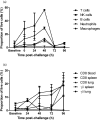Characterization of lethal inhalational infection with Francisella tularensis in the common marmoset (Callithrix jacchus)
- PMID: 20558585
- PMCID: PMC3052436
- DOI: 10.1099/jmm.0.020669-0
Characterization of lethal inhalational infection with Francisella tularensis in the common marmoset (Callithrix jacchus)
Abstract
The intracellular Gram-negative pathogen Francisella tularensis is the causative agent of tularaemia and is prevalent in many countries in the northern hemisphere. To determine whether the common marmoset (Callithrix jacchus) would be a suitable non-human primate model of inhalational tularaemia, a pathophysiology study was undertaken. Ten animals were challenged with approximately 10(2) c.f.u. F. tularensis strain SCHU S4 (F. tularensis subsp. tularensis). To look for trends in the infection, pairs of animals were sacrificed at 24 h intervals between 0 and 96 h post-challenge and blood and organs were assessed for bacteriology, pathology and haematological and immunological parameters. The first indication of infection was a raised core temperature at 3 days post-challenge. This coincided with a number of other factors: a rapid increase in the number of bacteria isolated from all organs, more pronounced gross pathology and histopathology, and an increase in the immunological response. As the disease progressed, higher bacterial and cytokine levels were detected. More extensive pathology was observed, with multifocal lesions seen in the lungs, liver and spleen. Disease progression in the common marmoset appears to be consistent with human clinical and pathological features of tularaemia, indicating that this may be a suitable animal model for the investigation of novel medical interventions such as vaccines or therapeutics.
Figures



Similar articles
-
Establishment of lethal inhalational infection with Francisella tularensis (tularaemia) in the common marmoset (Callithrix jacchus).Int J Exp Pathol. 2009 Apr;90(2):109-18. doi: 10.1111/j.1365-2613.2008.00631.x. Int J Exp Pathol. 2009. PMID: 19335549 Free PMC article.
-
Bioavailability and efficacy of levofloxacin against Francisella tularensis in the common marmoset (Callithrix jacchus).Antimicrob Agents Chemother. 2010 Sep;54(9):3922-6. doi: 10.1128/AAC.00390-10. Epub 2010 Jul 12. Antimicrob Agents Chemother. 2010. PMID: 20625157 Free PMC article.
-
Comparison of experimental respiratory tularemia in three nonhuman primate species.Comp Immunol Microbiol Infect Dis. 2015 Apr;39:13-24. doi: 10.1016/j.cimid.2015.01.003. Epub 2015 Feb 7. Comp Immunol Microbiol Infect Dis. 2015. PMID: 25766142 Free PMC article.
-
Live Attenuated Tularemia Vaccines for Protection Against Respiratory Challenge With Virulent F. tularensis subsp. tularensis.Front Cell Infect Microbiol. 2018 May 15;8:154. doi: 10.3389/fcimb.2018.00154. eCollection 2018. Front Cell Infect Microbiol. 2018. PMID: 29868510 Free PMC article. Review.
-
Comparative review of Francisella tularensis and Francisella novicida.Front Cell Infect Microbiol. 2014 Mar 13;4:35. doi: 10.3389/fcimb.2014.00035. eCollection 2014. Front Cell Infect Microbiol. 2014. PMID: 24660164 Free PMC article. Review.
Cited by
-
A ΔclpB mutant of Francisella tularensis subspecies holarctica strain, FSC200, is a more effective live vaccine than F. tularensis LVS in a mouse respiratory challenge model of tularemia.PLoS One. 2013 Nov 13;8(11):e78671. doi: 10.1371/journal.pone.0078671. eCollection 2013. PLoS One. 2013. PMID: 24236032 Free PMC article.
-
Development of an acute model of inhalational melioidosis in the common marmoset (Callithrix jacchus).Int J Exp Pathol. 2011 Dec;92(6):428-35. doi: 10.1111/j.1365-2613.2011.00791.x. Int J Exp Pathol. 2011. PMID: 22122591 Free PMC article.
-
Immunity to Francisella.Front Microbiol. 2011 Feb 16;2:26. doi: 10.3389/fmicb.2011.00026. eCollection 2011. Front Microbiol. 2011. PMID: 21687418 Free PMC article.
-
Septic tularemia in 2 cottontop tamarins(Sanguinus oedipus).Comp Med. 2012 Jun;62(3):225-8. Comp Med. 2012. PMID: 22776056 Free PMC article.
-
Marmosets as models of infectious diseases.Front Cell Infect Microbiol. 2024 Feb 23;14:1340017. doi: 10.3389/fcimb.2024.1340017. eCollection 2024. Front Cell Infect Microbiol. 2024. PMID: 38465237 Free PMC article. Review.
References
-
- Avery, F. W. & Barnett, T. B. (1967). Pulmonary tularemia. A report of five cases and consideration of pathogenesis and terminology. Am Rev Respir Dis 95, 584–591. - PubMed
-
- Brok, H. P. M., Hornby, R. J., Griffiths, G. D., Scott, L. A. M. & Hart, B. A. (2001). An extensive monoclonal antibody panel for the phenotyping of leukocyte subsets in the common marmoset and the cotton-top tamarin. Cytometry 45, 294–303. - PubMed
-
- Conlan, J. W., Chen, W., Shen, H., Webb, A. & KuoLee, R. (2003). Experimental tularemia in mice challenged by aerosol or intradermally with virulent strains of Francisella tularensis: bacteriologic and histopathologic studies. Microb Pathog 34, 239–248. - PubMed
-
- Dennis, D. T., Inglesby, T. V., Henderson, D. A., Bartlett, J. G., Ascher, M. S., Eitzen, E., Fine, A. D., Friedlander, A. M., Hauer, J. & other authors (2001). Tularemia as a biological weapon – medical and public health management. JAMA 285, 2763–2773. - PubMed
Publication types
MeSH terms
Grants and funding
LinkOut - more resources
Full Text Sources
Research Materials

